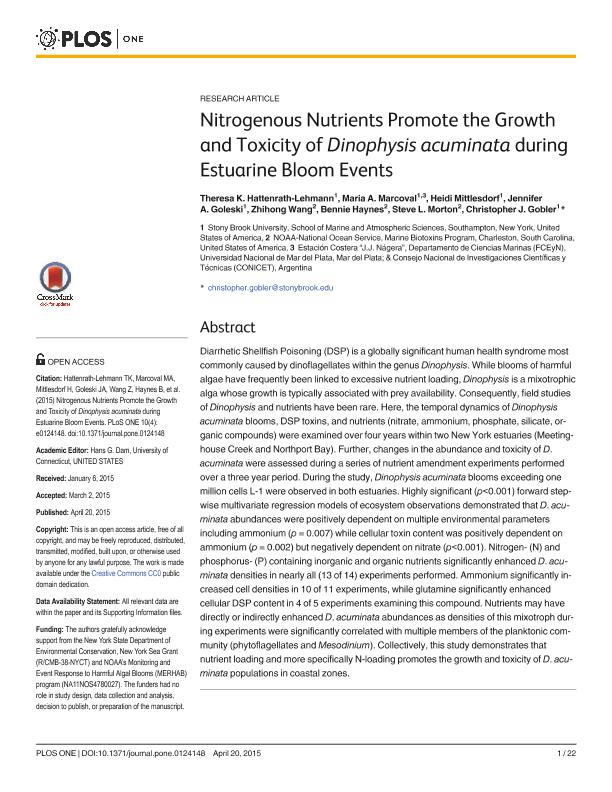Artículo
Nitrogenous Nutrients Promote the Growth and Toxicity of Dinophysis acuminata during Estuarine Bloom Events
Hattenrath Lehmann, Theresa K.; Marcoval, Maria Alejandra ; Mittlesdorf, Heidi; Goleski, Jennifer A.; Wang, Zhihong; Haynes, Bennie; Morton, Steve L.; Gobler, Christopher J.
; Mittlesdorf, Heidi; Goleski, Jennifer A.; Wang, Zhihong; Haynes, Bennie; Morton, Steve L.; Gobler, Christopher J.
 ; Mittlesdorf, Heidi; Goleski, Jennifer A.; Wang, Zhihong; Haynes, Bennie; Morton, Steve L.; Gobler, Christopher J.
; Mittlesdorf, Heidi; Goleski, Jennifer A.; Wang, Zhihong; Haynes, Bennie; Morton, Steve L.; Gobler, Christopher J.
Fecha de publicación:
04/2015
Editorial:
Public Library of Science
Revista:
Plos One
e-ISSN:
1932-6203
Idioma:
Inglés
Tipo de recurso:
Artículo publicado
Clasificación temática:
Resumen
Diarrhetic Shellfish Poisoning (DSP) is a globally significant human health syndrome mostcommonly caused by dinoflagellates within the genus Dinophysis. While blooms of harmful algae have frequently been linked to excessive nutrient loading, Dinophysis is a mixotrophicalga whose growth is typically associated with prey availability. Consequently, field studies of Dinophysis and nutrients have been rare. Here, the temporal dynamics of Dinophysisacuminata blooms, DSP toxins, and nutrients (nitrate, ammonium, phosphate, silicate, organic compounds) were examined over four years within two New York estuaries (Meeting house Creek and Northport Bay). Further, changes in the abundance and toxicity of D.acuminata were assessed during a series of nutrient amendment experiments performed over a three year period. During the study, Dinophysis acuminata blooms exceeding one million cells L-1 were observed in both estuaries. Highly significant (p<0.001) forward stepwise multivariate regression models of ecosystem observations demonstrated that D. acuminataabundances were positively dependent on multiple environmental parametersincluding ammonium (p = 0.007) while cellular toxin content was positively dependent on ammonium (p = 0.002) but negatively dependent on nitrate (p<0.001). Nitrogen- (N) and phosphorus- (P) containing inorganic and organic nutrients significantly enhanced D. acuminatadensities in nearly all (13 of 14) experiments performed. Ammonium significantly increased cell densities in 10 of 11 experiments, while glutamine significantly enhanced cellular DSP content in 4 of 5 experiments examining this compound. Nutrients may have directly or indirectly enhanced D. acuminata abundances as densities of this mixotroph during experiments were significantly correlated with multiple members of the planktonic community(phytoflagellates and Mesodinium). Collectively, this study demonstrates that nutrient loading and more specifically N-loading promotes the growth and toxicity of D. acuminatapopulations in coastal zones.
Palabras clave:
Nutrients
,
Growth
,
Dinophysis
,
Bloom
Archivos asociados
Licencia
Identificadores
Colecciones
Articulos(IIMYC)
Articulos de INSTITUTO DE INVESTIGACIONES MARINAS Y COSTERAS
Articulos de INSTITUTO DE INVESTIGACIONES MARINAS Y COSTERAS
Citación
Hattenrath Lehmann, Theresa K.; Marcoval, Maria Alejandra; Mittlesdorf, Heidi; Goleski, Jennifer A.; Wang, Zhihong; et al.; Nitrogenous Nutrients Promote the Growth and Toxicity of Dinophysis acuminata during Estuarine Bloom Events; Public Library of Science; Plos One; 10; 4; 4-2015; 1-22; e012414
Compartir
Altmétricas



